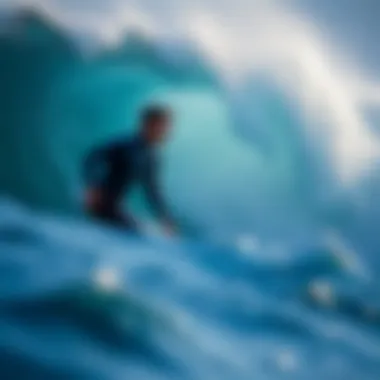Key Factors for Picking the Ideal Wetsuit for Surfing


Intro
Choosing the right wetsuit can feel like finding a needle in a haystack, especially with the plethora of options available. Surfers of all levels encounter common challenges; from battling the cold waters of the Pacific to navigating the lively waves of the Atlantic. Each environment demands different considerations when picking a wetsuit that not only meets the conditions but also aligns with personal comfort and performance. This guide aims to peel back the layers of wetsuit selection, shedding light on key materials, designs, features, and performance nuances that cater to your surfing journey.
When surfers step into that water, they are not just confronting the ocean, but embracing an experience unique to each undertaking. Whether it’s the thrill of catching your first wave or the exhilaration of executing an advanced maneuver, every surfer shares a deep connection with the sea. The wetsuit becomes an extension of that experience. Understanding its essentials empowers surfers to ride the waves and stay comfortable—regardless of whether the skies are sunny or stormy.
This comprehensive review is designed to provide valuable insights to every type of surfer—whether you’re just dipping your toes in or pushing the boundaries of your skills. You will learn everything from the foundational aspects of wetsuit materials to advanced tips that optimize both comfort and performance.
Let’s begin the journey together—dive deep into the essentials of choosing the right wetsuit.
Understanding Wetsuit Necessities
When diving into the world of surfing, a wetsuit is not just an accessory—it's a necessity. Understanding the essentials surrounding wetsuits can spell the difference between an exhilarating ride on the waves or an unfriendly encounter with frigid waters. Surfing isn’t merely about riding a board; it’s about harnessing the energy of the ocean while ensuring safety and comfort. That's where a well-chosen wetsuit steps onto the scene.
Why Wetsuits Matter
Wetsuits serve multiple purposes that directly impact a surfer's performance. First and foremost, they maintain your body temperature despite the cold water. Without this thermal protection, riding those glorious waves would soon turn into an unbearable struggle against hypothermia. Secondly, wetsuits can protect the skin from the harsh environment and potential injuries from underwater rocks or coral reefs. Whether you're a seasoned surfer or just starting out, investing in a good wetsuit goes a long way.
Besides comfort and safety, a wetsuit can enhance your overall surfing experience. They are designed to streamline your body, reducing drag as you paddle. This means more time catching waves and less time paddling against the currents. An effective wetsuit is a surfer's best friend in this sense, aiding both performance and endurance when it matters most.
Key Functions of a Wetsuit
Understanding the fundamental functions of a wetsuit is vital for anyone serious about surfing. There are three primary functions worth diving into: thermal insulation, wear protection, and buoyancy assistance.
Thermal Insulation
Thermal insulation is one of the standout features of any wetsuit. Keeping your body warm in cold waters is not simply about comfort; it directly affects how long you can stay in the water and your overall enjoyment of surfing. Wetsuits are designed to trap a thin layer of water between the suit and your skin, which gets warmed by your body heat. This unique characteristic allows for extended surf sessions without turning into an ice cube.
While standard neoprene suits offer decent thermal protection, advanced options like super stretch neoprene provide even better insulation and freedom of movement. For surfers who brave the chillier waters, thermal insulation becomes paramount in ensuring proper functionality and performance during surfing.
Wear Protection
Next up is wear protection. Surfing exposes you to more than just waves; it can also present risks of cuts, scrapes, and rashes. A good wetsuit acts as a shield against sharp objects in the water, like rocks or barnacles, and helps to prevent chafing from board contact. With features like reinforced knees and flatlock seams, the beste wetsuits offer that additional safeguard you need.
In addition to physical protection, wetsuits guard against UV rays. Long exposure to the sun can lead to severe skin damage. A well-designed wetsuit not only keeps you safe during wipeouts but also protects your skin while you soak in the sun.
Buoyancy Assistance
The final function, buoyancy assistance, sometimes gets overlooked, yet it plays a critical role in effective surfing. Buoyancy contributes to overall performance in the water. A good wetsuit’s material is formulated to add some buoyancy, making it easier to float and conserve energy while catching waves. This is particularly useful for beginners who may still be developing their paddling and balance skills.
A buoyant wetsuit can lift a surfer’s body slightly above water, which reduces fatigue during paddling. This uniquely advantageous feature enables surfers to catch more waves and extend their time in the water, fully enjoying their surfing experience.
"A wetsuit isn't just gear; it's the bridge between a surfer and the sea, enabling mastery over the waves while ensuring safety and comfort."
In summary, understanding why wetsuits matter and their key functions is essential for any surfer. Knowing how thermal insulation, wear protection, and buoyancy assistance contribute to performance helps in selecting the perfect suit that complements individual needs. With this knowledge, you stand on strong ground as you prepare to navigate through the waves ahead.
Material Composition
Choosing the right wetsuit goes beyond just style and color; it’s intrinsic to comprehending the materials that make up the suit itself. Material composition plays a crucial role in performance, durability, and comfort while surfing. An understanding of the several types of materials can help you make an informed choice about which wetsuit fits your needs best.
Neoprene Variants
Neoprene is the most widely acknowledged material in wetsuit production. The specifics of the neoprene variant can greatly affect flexibility, warmth, and environmental impact, making it a essential element of wetsuit selection.
Standard Neoprene
Standard neoprene is the traditional choice for many wetsuits. Its versatility is one of its major strong suits. This material provides a decent level of insulation, allowing surfers to stay warm while also being relatively buoyant. The thickness of the material can vary, offering different levels of warmth depending on water temperature. However, one drawback is that it may lack some flexibility compared to more modern alternatives. Surfers often appreciate its familiarity and cost-effectiveness, but if you're seeking enhanced movement in cooler waters, you might want to look elsewhere.
Super Stretch Neoprene
Super stretch neoprene is the cat's pajamas for those prioritizing flexibility. This material has a high degree of elasticity, allowing unrestricted movement, which is essential for performing tricks and paddling. Surfers enjoy this feature, especially when navigating cold waters, as it enhances comfort without compromising thermal insulation. However, it often comes at a higher price point than standard neoprene. The trade-off here is clear: superior flexibility but potentially lower longevity under rough conditions.
Eco-Friendly Neoprene
Eco-friendly neoprene is slowly gaining traction in the wetsuit industry, appealing to surfers mindful of their environmental footprint. Developed using non-toxic materials and processes that minimize environmental impact, this variant boasts reduced harmful emissions during manufacturing. Its eco-savvy nature does come with some compromises, such as potentially higher costs and reduced availability in the market. Nonetheless, it remains an appealing choice for surfers wishing to ride the waves with a conscious mind.
Other Material Ingredients
The composition of a wetsuit isn’t solely dependent on neoprene; other ingredients contribute significantly to overall quality and comfort.
Fleece Linings
Fleece linings are a notable feature in many modern wetsuits, particularly those designed for colder climates. This material provides an extra layer of insulation that keeps body heat from escaping. The soft texture is a pleasant addition that adds comfort against the skin. However, one thing to keep in mind is that fleece can absorb water, which may add weight when submerged, affecting overall buoyancy.
Glues and Seams


The gluing and stitching methods used in wetsuit construction can either make or break a suit’s longevity. Various seam types, such as flatlock or blind stitches, impact flexibility and water integrity. Neoprene glued with high-quality adhesives strengthens the suit, ensuring durability against wear and tear. Yet, poor seam construction can lead to leaks, diminishing the suit’s effectiveness. Therefore, look for wetsuits boasting industry-standard seam techniques to enhance their overall lifespan.
Zipper Materials
Zippers are often overlooked but are vital for both function and durability. High-grade materials ensure that zippers remain reliable throughout their lifetime. Waterproof zippers can greatly enhance insulation by preventing water from seeping in through openings. On the downside, zippers can sometimes snag or break, leading to inconvenience. Investing in a wetsuit with a robust zipper system can mitigate future woes.
"Material quality determines comfort and efficiency in the water, so choose wisely!"
Fit and Comfort
Choosing a wetsuit is like buying a second skin. The fit and comfort of the wetsuit play critical roles in how effective it is when you're out on the water. A well-fitting wetsuit not only keeps you warm but also allows for greater mobility. In surfing, every drop and turn demands fluid movement. If a wetsuit is too tight, it can restrict your movements, making it harder to paddle or pop up on your board. Conversely, a suit that is too loose can lead to chafing and water flushing in, which is neither cozy nor efficient.
An appropriate fit keeps the water between the suit and your body warmer for longer, allowing you to stay in the water without being hindered by the cold. Gaining an understanding of size, cut, and adjustability will help you make an informed decision.
Selecting the Right Size
Picking out the right size is vital; a suit that doesn’t fit can ruin the best of days. When choosing a size, manufacturers often provide a size chart, and it’s critical to consult that when purchasing. Consider your body measurements—chest, waist, and height are particularly important. Fitting into the range of the size guide often means finding a balance where the suit hugs snugly against your skin without feeling restrictive. Too often, surfers grab a wetsuit based on how long they've been surfing instead of their actual measurements.
Cut and Design Considerations
The cut and design of a wetsuit can heavily influence its suitability based on the conditions and your personal preferences. Understanding these differences can guide you in making a choice that complements your surfing style.
Fullsuits vs. Springsuits
Both fullsuits and springsuits hold their merits, and each serves a specific purpose. Fullsuits cover the entire body, typically providing maximum thermal protection. They tend to be the go-to choice for colder waters, offering significant insulation due to their longer sleeves and legs. What separates fullsuits from springsuits is their design; springsuits feature short sleeves and legs, granting surfers additional mobility in warmer conditions. So, if you're planning on surfing in warmer temperatures, springsuits are a popular pick because they provide enough coverage without overheating you.
Short Sleeve vs. Long Sleeve
In the realm of wetsuits, you can choose between short sleeve and long sleeve designs based on temperature and personal preference. Short sleeve wetsuits often welcome warmer weather while still offering some protection against the elements, allowing ample freedom for arm movement. On the other hand, long sleeve wetsuits better mitigate the effects of cold in breezy or cooler temperatures while still allowing for flexibility. Notably, a long sleeve provides extra arm insulation, which is key when battling chilly currents every now and then. It’s crucial to balance comfort with the climate you’ll encounter.
Adjustability Features
The adjustability of your wetsuit can greatly affect its snugness and comfort. These features allow surfers to personalize their suits, making it better suited to one's specific body shape.
Neck Seals
Neck seals are an important part of wetsuit design, particularly for those navigating icy waters. A good neck seal offers a snug fit, keeping water from seeping into the suit. Thus, it plays a vital role in maintaining body temperature during extended periods in colder conditions. A seal that is too tight, however, may restrict movement or be uncomfortable, and that can be rather distracting. Testing for comfort here is crucial for long surf sessions.
Wrist and Ankle Seals
Similarly, wrist and ankle seals help to prevent water from entering the suit, maintaining that necessary thermal barrier. A well-fitted wrist seal can reduce water ingress during strong paddling or wipeouts. They provide that all-important snug feeling, which lets you focus entirely on the waves rather than what’s going on inside your suit. A grip at these points reduces the chances of flushing but can become uncomfortable if sized incorrectly. Therefore, it’s vital to pay attention to how the seals feel when you’re putting on the suit or when you’re in action.
Overall, making thoughtful choices regarding fit and comfort can elevate your surfing experience, allowing you to focus on catching waves rather than constantly adjusting your gear.
Temperature Ratings
Temperature ratings are essential when selecting a wetsuit, as they directly influence comfort and performance in varying water conditions. Understanding these ratings helps surfers match their wetsuit choice with the seasonal environment, ensuring they remain warm enough without overheating while enjoying their surf sessions. Each wetsuit is designed for specific temperature ranges that dictate material thickness and features, making it crucial to be well-acquainted with these guidelines.
Understanding Temperature Guidelines
When talking about temperature guidelines, it’s about knowing the optimal conditions for the wetsuit’s effectiveness. Wetsuits are typically categorized based on the water temperature they are suited for. These range classifications help surfers identify which wetsuit to wear based on expected conditions. For example, a wetsuit rated for cold waters is usually thicker, providing extra thermal insulation through heavy neoprene, whereas suits for warmer waters tend to be thinner and lighter, promoting ease of movement.
The temperature guidelines can differ from one brand to another, so it’s a wise move to check the specific recommendations of the wetsuit in question. A common rule of thumb is as follows:
- Above 75°F (24°C): Generally, no wetsuit or only a shorty is required.
- 65°F to 75°F (18°C to 24°C): A standard shorty or thin full suit may be suitable.
- 58°F to 65°F (14°C to 18°C): A thicker wetsuit is generally needed.
- Below 58°F (14°C): A 5mm or thicker suit is often required, maybe with booties and gloves.
The right suit should offer a snug fit that limits water entry, while still allowing for comfortable movement. It’s all about balancing warmth, flexibility, and user comfort.
Seasonal Considerations
Winter
Winter brings unique challenges for surfers due to the plummeting water temperatures. A wetsuit designed for winter surfing often ranges from 4mm to 6mm in thickness, ensuring that body heat is preserved while battling frigid water. The key characteristic here is insulation. A good winter wetsuit not only insulates but also maintains flexibility, allowing for the agility needed to navigate the waves. However, the downside can be the sheer bulk of the thicker suits, which may limit movement compared to lighter suits. Surfing in winter can be a refreshing experience, provided you’re well-prepared with the right gear.
Spring
As the weather warms up, spring surfing offers a delightful transition from winter’s chill. A spring wetsuit—often around 3mm in thickness—balances warmth with increased mobility. The characteristic here is versatility, allowing for varied water conditions, which can swing from cool to nearly warm as temperatures rise. Spring suits are often constructed with strategic panels of super-stretch neoprene, enabling greater freedom of movement while keeping you sufficiently insulated on cooler days. However, users should be mindful of warming water; overheating can occur if temperatures jump unexpectedly.
Summer
Summer is arguably the most enjoyable time to hit the waves, where the water temperature can make for a lighter approach. A summer wetsuit can be as thin as 1mm to 2mm—often sleeveless or featuring short sleeves. The advantage is clear; they provide just enough coverage to ward off a chill without suffocating the wearer with heat. This ideal balance allows surfers to feel free and agile while soaking up the sun. Still, there’s a catch; as the sun heats up, one must choose wisely to avoid excess warmth that can lead to discomfort during long surf sessions.
Fall
Fall surf conditions are often referred to as some of the best across many coasts, with warmer water from summer still lingering. Wetsuits during this season typically hover around the 3mm to 4mm mark, adapting to the cooling temperatures. The charm of fall wetsuits lies in their capability to keep surfers warm while still offering enough flexibility for fluid movement. However, as the season progresses, careful attention to temperature changes is necessary, as the transition into winter can mean investing in thicker suits. Fall can be a mixed bag, but typically, surfers enjoy prolonged sessions in vibrant water amid spectacular coastal landscapes.


The wetsuit choice varies greatly between seasons, highlighting the necessity to adapt based on changing temperatures and surf conditions.
Performance Attributes
Choosing a wetsuit isn’t only about picking a snazzy design or a color that stands out in the surf. Performance attributes are key to ensuring that the wetsuit serves its essential purposes effectively. These attributes stretch beyond just how the wetsuit looks; they significantly impact how a surfer moves, stays comfortable in varying conditions, and enjoys their time in the water.
Flexibility and Mobility
Flexibility is crucial when considering wetsuits. A flexible wetsuit allows for greater freedom of movement, which is particularly important when paddling or executing maneuvers on the wave. The thickness and type of neoprene used can affect this aspect greatly. For instance, a wetsuit featuring super stretch neoprene tends to offer more give, making it easier for surfers to twist, bend, and ride with agility.
Moreover, a well-designed wetsuit should hug your body snugly without feeling restrictive. If you can’t move with ease, you might as well be wearing a straitjacket in the water. Models that sport articulated arms and knees often enhance mobility, allowing surfers to perform complex movements seamlessly. All in all, a wetsuit that enhances flexibility equates to more enjoyable and efficient surfing.
Durability and Longevity
When it comes to durability, the wetsuit should be built to endure the rigors of surfing. The ocean can be a fierce adversary; knowing your wetsuit can withstand tears and wear is essential. Durability hinges greatly on quality materials and construction methods.
Seam Types and Quality
The seams in a wetsuit can make or break its lifespan. You’ve got multiple seam constructions available, from flatlock seams to blind stitched seams. Flatlock seams are easier and cheaper to produce but aren't as watertight. On the other hand, blind stitched seams provide a flat finish and greater water resistance, making them a popular choice among seasoned surfers.
Key characteristics to look for include:
- Water Resistance: Quality seams prevent water from leaking in, keeping you warm.
- Flexibility: Seams should not inhibit movement; hence the type of seam is crucial.
Each seam type carries its pros and cons. A sturdy, long-lasting seam means fewer repairs over time, enabling endless hours on the waves without worrying about wetsuit malfunctions.
Warranty Considerations
When investing in a wetsuit, the warranty offered by the manufacturer can be a critical factor. A good warranty signifies the brand's confidence in the product's durability. Look for brands that offer warranties against defects in materials and craftsmanship, as this can save you hassles down the line.
A notable feature of warranties is that they often cover a specified period. A longer warranty typically suggests that the company stands behind its product's quality. This added assurance can provide peace of mind—if you encounter an issue, you won’t be left high and dry.
Furthermore, paying attention to the warranty fine print can offer insights: what exactly is covered? Are accidental damages included, or just manufacturing defects? The answers can greatly influence your purchasing decision and future frustrations.
End
In sum, performance attributes are not merely a set of numbers or marketing buzzwords; they play a pivotal role in your overall surfing experience. From flexibility that ensures fluid movements to a durable construction that stands the test of time, knowing what to look for can significantly improve your enjoyment on the waves.
Remember, every surfer is unique, and tailoring your selection to your specific needs and surfing style will yield the best results.
Environmental Awareness
Choosing the right wetsuit isn't just about personal comfort and performance in the water; it's also deeply intertwined with environmental considerations. As surfers, swimmers, and ocean aficionados, our choices ripple through ecosystems. Selecting eco-friendly wetsuits is vital not only for personal satisfaction but also for helping preserve the waters we love. The production and disposal of wetsuits can have significant effects on ocean health, making awareness of these aspects crucial for informed decision-making.
Eco-Friendly Options
Biodegradable Wetsuits
One fascinating development in the world of wetsuits is the emergence of biodegradable wetsuits. These suits are designed to break down naturally over time, reducing their impact on landfills and the oceans. Traditional wetsuits, often made from synthetic materials like neoprene, can take decades to decompose. In contrast, biodegradable options utilize more sustainable materials, making it easier for them to return to the Earth after their useful life.
The most compelling characteristic of biodegradable wetsuits is their commitment to reducing waste— a huge bonus for environmentally-conscious surfers. While they may come with a slightly higher price tag, many see them as a worthwhile investment for protecting the environment. A unique feature of these suits is that they can be composted in the right conditions, offering a drastically different end-of-life scenario compared to conventional wetsuits.
Advantages:
- Decomposes within a shorter time frame compared to traditional materials.
- Significantly lowers environmental pollution.
Disadvantages:
- Higher initial cost might deter some buyers.
- Limited availability of models and brands on the market.
Sustainable Manufacturing Practices
Sustainable manufacturing practices in wetsuit production emphasize minimal environmental impact. Brands are increasingly adopting processes that reduce energy consumption and waste during manufacturing. For instance, companies might utilize renewable energy sources or focus on producing wetsuits in smaller batches to limit surplus.
The key characteristic of these practices is the emphasis on ethical sourcing of materials and responsible manufacturing processes. This shift towards sustainability resonates well with a demographic that already values environmental responsibility, making it a popular choice among modern consumers.
Unique aspects such as water-based adhesives and eco-friendly dyes play a pivotal role in reducing harmful emissions. Furthermore, companies prioritizing sustainable practices often showcase transparency in their supply chain, offering consumers insights into where and how their wetsuits are made.
Advantages:
- Reduction in carbon footprint during production.
- Enhanced transparency allows for more informed consumer decisions.
Disadvantages:
- Products might not be widely available in all regions.
- Some durable features may be sacrificed for sustainability.


Impact on Ocean Health
Ocean health is a growing concern, and the materials and practices used in wetsuit production can contribute significantly to or detract from it. When selecting a wetsuit, it's not just the comfort or performance you should consider; think about how your choice impacts marine ecosystems. Opting for environmentally friendly suits means supporting a trend that can ultimately help preserve the vibrant waters and the wildlife within them.
By embracing eco-friendly practices and making informed purchasing decisions, surfers can actively participate in protecting our oceans for future generations. Every small choice contributes to a larger movement toward sustainability in the water sports community. In the end, it's not just a wetsuit; it's a step towards a healthier planet.
Cost Considerations
When it comes to picking a wetsuit, understanding the financial aspect is crucial. The cost of a wetsuit can vary significantly, impacted by factors such as material quality, brand reputation, and specific features tailored for different water conditions. A lesser-known maker might offer a seemingly acceptable wetsuit at a bargain price, but often, you get what you pay for. Quality tends to come with a price tag; hence, knowing how to balance your budget with the potential value of your investment is key.
Investment vs. Value
Investing in a wetsuit is not merely about the initial cost. Though your wallet might feel lighter after a purchase, it's more about the long-term value. A higher-priced wetsuit can, in fact, save you more cash over time through durability and performance. For example, a mid-range suit might fall apart after a couple of seasons, while a more expensive option could last you several years. Here's why thinking investment rather than mere cost is beneficial:
- Durability: Premium materials tend to resist wear and tear better.
- Performance: Higher-quality suits often provide superior insulation and flexibility, enhancing your overall surfing experience.
- Resale Value: A well-maintained premium wetsuit can often fetch a reasonable price if you decide to sell it later.
Don’t overlook the importance of warranty options as well, which can provide peace of mind. A reputable brand may offer a warranty that protects your investment, thereby enhancing its value.
Choosing Budget-Friendly Options
Not everyone is in a position to splash out on an expensive wetsuit, and that’s perfectly fine. There are ways to find budget-friendly options without sacrificing too much quality:
- Look for Sales and Off-Season Discounts: Many brands run sales or offer discounts during the off-season, so keep an eye out.
- Consider Second-Hand Options: A well-cared-for second-hand wetsuit, when sourced from a reputable platform like eBay or specific surf community groups, can be a gold mine.
- Research Lesser-Known Brands: Often, there are up-and-coming brands producing quality suits at a lower price point without all the marketing fluff.
Ultimately, the goal is to find a wetsuit that fits your needs and budget. Quality doesn't always mean high price; it’s about finding the right balance.
"In the world of surfing, the perfect wetsuit doesn't have to break the bank; it just has to fit right and keep you warm."
For further reading on cost-effective options, refer to resources like Wikipedia or professional surf forums on sites like Reddit. Gather insights from other surfers' experiences to help guide your purchasing decision.
User Reviews and Recommendations
Navigating the sea of wetsuit options can feel like being caught in a riptide. That’s where user reviews and recommendations come into play. These insights act like a compass, providing guidance from those who have firsthand experience. They help potential buyers understand not just the technical specs of a wetsuit, but also how it performs in real-world conditions.
When considering different wetsuits, delving into user reviews lets you grasp the nuances that specifications might not fully convey. From comfort levels during long surf sessions to how well a suit holds up against the wear and tear of oceanic elements, real user feedback uncovers critical details.
Key Brands in the Market
The wetsuit market is saturated with numerous brands, each boasting unique designs and technologies. Some key players include:
- O'Neill: Known for innovation and a wide range of options, O'Neill’s suits offer durability and comfort, appealing to surfers of all levels.
- Rip Curl: Their wetsuits are often praised for their flexibility and warmth, making them a favorite among those venturing into colder waters.
- Billabong: With a focus on style as well as functionality, Billabong appeals to both performance-driven and fashion-conscious surfers.
These brands not only have solid reputations but also plenty of customer feedback available for prospective buyers to sift through.
Real User Experiences
Beginner Insights
For those just dipping their toes into the surfing world, beginner insights can be invaluable. New surfers often prioritize ease of use and comfort. Wetsuits that are easy to put on and offer a forgiving fit can alleviate some stress for beginners. Many rookie surfers recommend options that feature short sleeves or even springsuits for warmer waters, as these allow for more comfortable movement and quicker drying times.
A notable feature in beginner-geared suits is the entry-level pricing combined with satisfactory performance. Affordable wetsuits might lack some advanced features but generally provide adequate warmth and flexibility for casual outings. The downside can be longevity; these suits might not hold up as well in the long run compared to pricier models. However, this trade-off often suits newcomers well who are still figuring out their ingrained surfing habits.
Advanced Surfer Perspectives
In contrast, seasoned surfers offer a different set of insights. Their focus usually centers on performance and specialized features. For instance, various advanced wetsuits come with glued and blind stitched seams that enhance durability without compromising flexibility. These surfers often emphasize the importance of temperature ratings and how a perfectly fitted suit can greatly enhance performance during critical waves.
Advanced surfers might zero in on brands like Xcel or Patagonia, known for their high-performance suits that cater to the specific needs of more experienced riders. However, the flip side for these suits is often the cost, as high-quality materials and intricate design lead to considerable investments. Yet for many, the benefits—like enhanced buoyancy and thermal management—justify the expense.
"Choosing the right wetsuit is like finding the perfect board; it can make or break your experience on the waves."
By gathering insights from both beginners and experts, the comprehensive understanding gained can steer anyone toward a wetsuit that meets their unique needs. Whether you're just learning to ride the waves or you're already carving the ocean like a pro, these experiences are critical to making an informed decision.
Final Thoughts
When it comes to selecting the perfect wetsuit, the choices can be as vast as the ocean itself. This article delved deep into crucial considerations that can greatly enhance a surfer's experience. Final thoughts summarize these key points while guiding potential buyers in personalizing their choices according to individual needs and preferences.
The essence of choosing a wetsuit isn't merely about keeping warm; it affects performance, safety, and enjoyment in the water. Finding a balance between comfort, functionality, and environmental impact cannot be understated. The right wetsuit can mean the difference between a session filled with excitement or one riddled with discomfort.
"A good wetsuit is like a second skin, aiding your movements while shielding you from the elements."
Summary of Essential Features
Understanding essential features of a wetsuit is paramount. While diving into materials, fit, and thermal properties earlier in this article, it's crucial to recap these aspects:
- Material Composition: The type of neoprene used—whether it's standard, super stretch, or eco-friendly—plays a significant role in flexibility and warmth. Each variant caters to different needs, showcasing the innovation in today’s wetsuit designs.
- Temperature Ratings: Aligning your wetsuit choice with water temperatures ensures that you stay comfortable. Knowing seasonal guidelines—how a wetsuit performs across winter, spring, summer, and fall—is essential for any ocean enthusiast.
- Fit and Comfort: A wetsuit must fit snugly without constricting movement. Consider the cut and adjustability features; they can greatly impact your surfing experience. Remember, every surfer's body is unique, and so should be the fit of their wetsuit.
Personalizing Your Choice
Personalization is where the real magic happens. The right wetsuit should feel tailor-made for you. Here are some reflective thoughts to consider:
- Assess Your Activities: Are you primarily into surfing, paddleboarding, or diving? Each sport may require different specifications in wetsuits.
- Understand Your Local Conditions: Local water temperatures and conditions dictate wetsuit thickness and style. If you're surfing in colder waters, perhaps look into thicker suits with enhanced thermal insulation.
- Preferences in Flexibility and Style: Some surfers prefer more mobility while others might emphasize thermal retention. Think about what feels right.
- Consider Environmental Impact: In our eco-conscious era, opting for manufacturers who prioritize sustainable practices could make you feel better about your choice.
In the end, choosing the right wetsuit is about balancing personal preferences with practical features. This ensures that whether you're out catching waves or exploring coral reefs, you can do so with confidence and comfort.



